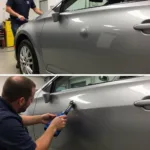Choosing the right welding method for car body repair—MIG, TIG, or arc—can be crucial for a successful and long-lasting fix. This article dives into the nuances of each technique, helping you understand which is best suited for your specific car body repair needs. We’ll cover everything from the basics of each process to the pros and cons, empowering you to make informed decisions about your vehicle’s restoration.
Understanding the Welding Trinity: MIG, TIG, and Arc
MIG (Metal Inert Gas) welding, also known as GMAW (Gas Metal Arc Welding), is a popular choice for car body repair due to its relative ease of use and speed. It uses a continuously fed wire electrode shielded by an inert gas, typically argon or a mixture of argon and CO2. This shielding gas protects the weld from atmospheric contamination, resulting in a clean and strong weld. MIG welding is particularly effective on thinner sheet metal commonly found in car bodies.
TIG (Tungsten Inert Gas) welding, or GTAW (Gas Tungsten Arc Welding), offers greater precision and control compared to MIG. It uses a non-consumable tungsten electrode to create the arc, and a separate filler rod is added to the weld pool. TIG welding allows for more delicate repairs and is excellent for welding aluminum and other non-ferrous metals sometimes found in car components. However, it requires more skill and is generally slower than MIG welding.
Arc welding, also known as SMAW (Shielded Metal Arc Welding), is the oldest and simplest of the three methods. It uses a consumable electrode coated in flux, which creates a shielding gas as it burns. While arc welding is less common for car body repair due to its rougher finish and higher heat input, it’s a viable option for thicker gauge metal and repairs where cosmetic appearance is less critical. It’s also a very portable option, making it suitable for fieldwork.
Which Welding Method is Right for Your Car Body Repair?
Choosing between MIG, TIG, and arc welding for car body repair depends on several factors, including the type of metal being welded, the thickness of the metal, the desired finish, and the welder’s skill level.
- For thin sheet metal and general car body repairs: MIG welding is often the preferred choice. Its speed and ease of use make it ideal for patching holes, repairing rust damage, and joining panels.
- For precise welds on aluminum or thin sheet metal requiring a high-quality finish: TIG welding is the best option. Its control and precision allow for clean, aesthetically pleasing welds.
- For thicker gauge metal and repairs where appearance is less critical: Arc welding can be a cost-effective solution, especially for DIY repairs or situations requiring portability.
Common Car Body Repair Welding Scenarios
- Rusty Rocker Panels: MIG welding is typically used to patch or replace rusted rocker panels due to its speed and ability to handle the varying thicknesses of metal often encountered in these areas.
- Dented Fenders: Depending on the severity of the dent and the desired finish, either MIG or TIG welding can be used for fender repairs. MIG is suitable for pulling out dents and filling small holes, while TIG is preferred for creating seamless repairs on visible areas.
- Cracked Frame Rails: For structural repairs like cracked frame rails, arc welding can be a good choice due to its ability to penetrate thicker materials. However, MIG welding can also be used with proper joint preparation and technique.
“Choosing the right welding method is paramount for a successful car body repair,” says expert automotive engineer, Amelia Hernandez, Ph.D. “Understanding the characteristics of each process is key to ensuring the structural integrity and longevity of the repair.”
Conclusion: Welding Your Way to a Perfect Repair
Selecting the appropriate welding technique—MIG, TIG, or arc—is essential for achieving a successful car body repair. Consider the specific needs of your project, including the type and thickness of the metal being welded, the desired finish quality, and your welding experience. By carefully evaluating these factors, you can ensure a durable and aesthetically pleasing repair that restores your vehicle to its former glory. Car body repair welding, whether MIG, TIG, or arc, is a skill that requires practice and knowledge.
“A well-executed weld can mean the difference between a quick fix and a lasting repair,” adds Hernandez. “Invest the time to understand the nuances of each method, and your car will thank you for it.”
FAQ
- What is the easiest welding method for beginners? MIG welding is generally considered the easiest for beginners due to its automatic wire feed and simpler setup.
- Which welding method provides the strongest welds? While all three methods can create strong welds, TIG welding often produces the highest quality and strongest welds, especially on thinner materials.
- Can I weld aluminum with a MIG welder? Yes, but you need a specific MIG welder designed for aluminum and specialized aluminum wire.
- What safety precautions should I take when welding? Always wear appropriate safety gear, including a welding helmet, gloves, and protective clothing. Ensure proper ventilation and work in a well-lit area.
- How much does it cost to have a car body welded? The cost depends on the extent of the damage, the welding method required, and labor rates in your area.
- Is car body welding a DIY project? While some simpler welding tasks can be done DIY, complex repairs are best left to professionals.
- What type of welding is best for exhaust repairs? MIG welding is typically used for exhaust repairs due to its speed and effectiveness on thinner materials.
Need help with car body repair? Contact us via WhatsApp: +1(641)206-8880, or Email: [email protected]. We offer 24/7 customer support.

